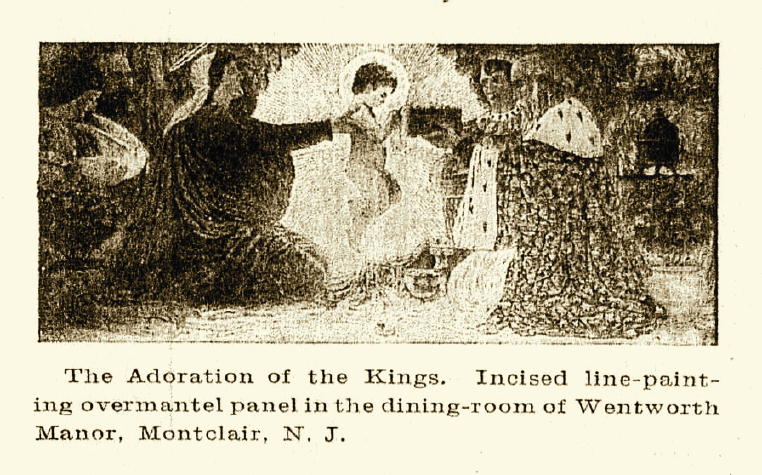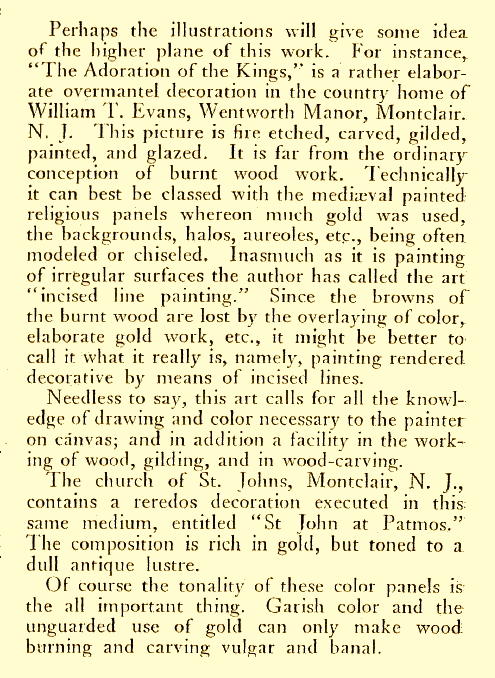E-Museum of Pyrographic ArtAntique Art Hall
|
| - Café Flambé - | - Portraits and Paintings - | - Decorative and Applied Art - |
| - Folk and Traditional Art - | - Antique Art - | - Special Hall - | - Sculpture - |
| - Children's Hall - | - Bookstore and Library - | - Tools and Techniques - |
 |
 |
| J. William Fosdick, On His 20th C. Technique
Excerpt and image adapted from his article Fire Etching in Home Decoration, Country Life Magazine, January 1909, p. 290. |
Whereas William Fuller Curtis can be categorized as a 20th Century pyrographic artist because that is when his pyrographic technique fully developed into the sophisticated, rich technique that made him famous, J. William Fosdick can best be considered a 19th Century pyrographic artist, because his earlier career was the one in which his pyrography was the dominant technique (and sometimes the only one used), starting with his first commission for financier Edward Dean Adams in 1884.
Fosdick's work "The Adoration of the Kings," shown above, is the only image we have thus far of this work that was found cited some time ago as belonging to art collector and philanthropist William T. Evans. It is adapted here from a poor quality photocopy from a public library of a small image in Fosdick's 1909 article in Country Life Magazine. Despite the poor image, it is gratifying to see at long last the unusual composition that Fosdick created for this traditional motif. This work decorated William Evans' own home in Montclair, New Jersey, while another work by Fosdick done in this later technique, "St. John at Patmos," was donated by Evans to the Episcopal church in that city. A third work that Evans owned and ultimately donated to the Smithsonian in Washington, D.C., is the one considered Fosdick's masterpiece—his triptych of the "Glorification of Joan of Arc"—that exemplifies his earlier, predominantly pyrographic technique.
*** NEWSFLASH! 7 February 2010: Another work by Fosdick has come to light as being one owned by William T. Evans. It is called The Welcome and is now on exhibit in the E-Museum at the link here. Furthermore, according to its caption, it was "one in a series" of panels decorating the Evans home.
*** NEWSFLASH! 8 December 2009: Fourteen panels by Fosdick—The Stations of the Cross—are now on exhibit in the E-Museum at the link here. These panels, which are not so much traditionally pictorial as they are decorative in type, are very representative of Fosdick's incised line technique. The images are color photographs taken in 2008 by Sharon H. Garvey at the Church of the Immaculate Conception in Waterbury, Connecticut, U.S.A.
Because so many of the sources for Fosdick's works were not published in color, i.e., those of his own time, it is even more important to have discovered this detailed description of his incised line technique in his own words. In addition, because in his 20th Century works pyrography was not the dominant technique, it has been essential in verifying that they are, in fact, pyrographic.
In the 1915 article "A Pentaptych by J. W. Fosdick," written by W. Laurel Harris, the author introduces Fosdick's works in elaborate detail. In his concluding paragraph, he lists in a tone of great admiration the many techniques—"carved, tooled, guilded, painted and stained"—that Fosdick employed in the making of those five exquisite panels. One technique, however, was blatantly omitted, and that was pyrography, unless it can be said it was subsumed in the word "tooled" that Harris used.
In other accounts, his techniques employed are not often mentioned more than to refer to his 20th Century works as paintings. Fosdick himself, in another 1915 article that he himself wrote about the Architectural League's exhibit that year, referred to his own work as follows:
"The east wall of this gallery is dominated by a pentaptych of painted panels on wood by J. William Fosdick, illustrative of the life of Joan of Arc."
Needless to say, it was reassuring to find confirmation by Fosdick himself in his description displayed here that his 20th Century technique of "incised line painting" was indeed a pyrographic technique integral to his 20th Century work.
*** NEWSFLASH! 25 February 2010: Another comment by Fosdick has come to light about his Incised Line Technique linked here to the final two paragraphs that are also quoted below:
"As to the use of color, the writer considers this to be a separate subject, with intricacies and methods which virtually brings another art into the field, viz.: that of Incised Line Painting wherein the color and gilding becomes the dominant issue, the wood burning taking a secondary place.
We believe, however, that this latter art can be carried forward on the lines of the old Italian incised and painted panels in a charming manner, possessing qualities which could be produced by no other process."
If you have either any questions to ask or any additional information to offer on J. William Fosdick's later technique of incised line painting, please e-mail the E-Museum Curator.
We believe, however, that this latter art can be carried forward on the lines of the old Italian incised and painted panels in a charming manner, possessing qualities which could be produced by no other process."
You are leaving the exhibit of
J. William Fosdick's
Incised Line Painting Technique
Described in His Own Words.
You can return to the
Antique Art Hall
or continue on your tour to one of the following:
Pyrographic Art Exhibit Halls:
Portraits and Paintings
Decorative and Applied Art
Sculpture
Folk and Traditional Art
Children's Pyrographic Art
Special Pyrographic Art
The Book Store and E-Museum Library
Pyrography Tools and Techniques
Your questions and comments are welcome and appreciated. Please e-mail the E-Museum Curator.
Back to E-Museum Entrance homepage
© 2009, 2010 Kathleen M. Garvey Menéndez, all rights reserved.
Last updated 25 February 2010.

